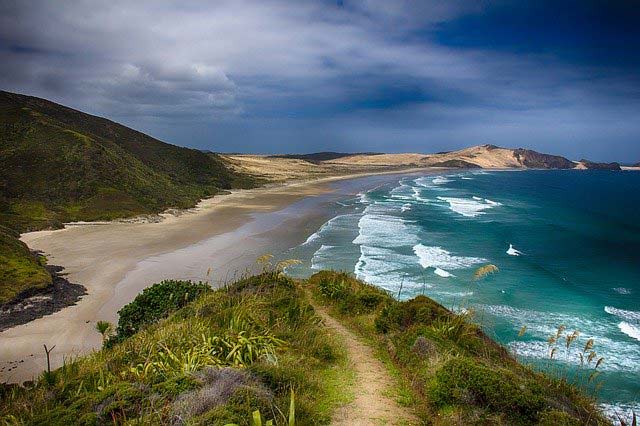Dexway English Magazine: B1 – Edition 2
New Zealand
Learning English opens up your world. You can travel and learn about different cultures in countries where English is a national language.
New Zealand is one of those countries. It is an island in the southwestern Pacific Ocean. Because of its remoteness, it was one of the last lands to be inhabited on Earth. It is home to many *endemic specific or animals and vegetation. A citizen of this country is called a New Zealander or informally a “Kiwi”. It is home to many famous people such as Sir Edmund Hillary, who climbed Mount Everest in 1953 and Baron Ernest Rutherford, the first person in the world to split the atom in 1919.
The national flag of New Zealand consists of a blue ensign and a Union Jack (The flag of the United Kingdom) in one corner and 3 stars, which are from the Southern Cross, the brightest stars in the Southern Hemisphere. The current flag was used from 1841, when New Zealand became a British Colony. New Zealand and its neighbour, Australia, both have the Queen of England as their Head of State; again, showing the colonial past of these countries. In New Zealand drivers drive on the left hand-side of the road, the same as in the UK. If you are interest in which side of the road to drive on in different countries, take a look at this web-site:
http://whatsideoftheroad.com/
New Zealand has a rich heritage of Māori heritage. Polynesians settled there in 1250–1300 and European settlers in 1642. There is a traditional Māori war dance called the Haka that the New Zealand national rugby team performs at the start of each match. Rugby is the national sport, and they are called The New Zealand All Blacks. Tourism and adventure sports have always been huge industries in thanks to the incredibly beautiful scenery.
New Zealand was the country that invented bungee jumping and Zorbing. (Zorbing is rolling down a hill in a huge inflatable balloon). But the tourism industry in New Zealand had a sudden boom after the success of The Lord of the Rings’ series of films. The director, Peter Jackson, is a native, and the films were all shot there. Many fans of the films travel to New Zealand to see some of the locations and to re-enact their favourite scenes.
Do you like playing or watching rugby? Why or why not?
What do you think about The Lord of the Rings trilogy?
Would you like to visit New Zealand?
*Endemic– animals or plant life that can easily become extinct or endangered from changes in their ecosystem because they have evolved in very isolated and unique habitats.

Feedback
THE NEVER ENDING LOOP
How can we find out if the customer is actually happy, what if they have the next biggest idea but cannot communicate it to us? We need feedback, every company needs feedback and we need to organise a feedback loop so that everything that is said is used to make our product or service better.
What about our employees, how do we know that the policies and objectives that we set for them are being met? We can use PI (performance indicators), tracking how many calls or how many keystrokes. But to really communicate with our employees we need to set in place a feedback loop. By loop we actually mean taking the suggestions and putting them into practice, when the opportunity for feedback comes around again, we can evaluate these changes and fine-tune them.
How? The first thing to do is to remember whenever you ask a customer for feedback, they will give you exactly what they think, their view of the world with their expectations and likes and dislikes.
Some companies use surveys at the end, or technical support calls to get instant feedback, we can also use mail surveys with simple multiple choice or rating questions or we can follow up sales with after-sales calls; communicating with customers is not hard.
For our employees, we can give them a yearly or a six monthly appraisal and ask them how they are doing, we can review performance and, with the help of the employee, we can set new targets or objectives. A basic survey can be given to employees to look at specific questions or proposed changes. The easiest way is to put a suggestion box, but take each suggestion seriously. If the employee is asking for a change in dress code on a Friday, think about it.
Work clothes
Until very recently there have been very strict guidelines regarding what people wear to work. Work clothes tend to fall into one of three categories:
- Uniforms
- Protective clothing
- Formal clothes
If you work on a building site it makes sense to wear steel toecap boots and a hardhat. And if you work for a franchise that deals with the public, like a large chain of retail outlets, then you will probably have to wear a uniform. Wearing a uniform can be annoying if it is not a very cool outfit, but customers need to know who they can ask for information and advice, so a uniform is necessary (although I’m sure the employees at large chains would be happier if their uniforms were all made by Calvin Klein!).
The other category is formal clothes; the suits, ties, leather shoes, dresses and skirts worn by the men and women that work in offices. It has traditionally been considered that wearing formal clothes gives an impression of professionalism to any stakeholder that might come to the office, such as a shareholder or client. It might also make people feel as though they have a responsibility to work to a certain level of professionalism; if the employees look smart then the work will be smart as well.
But these ideas have started to be questioned, and not just by the dress-down Friday policy that many offices have, where staff do not have to dress as formally on Fridays, but by an idea that was started by the company Google (you might have heard of them!). Google’s employees started turning up to trade fairs and conferences and they weren’t wearing their best suits and neatest dresses with freshly ironed shirts and blouses but ripped jeans, shorts, sandals, T-shirts, and sometimes, they didn’t even look like they’d brushed their hair. Their idea was that they did not have to put any effort into the appearance of their employees because their products were so good that their image was irrelevant.
Fishing.
THE OLDEST HOBBY
IN THE WORLD
Studies of skeletal remains of Tianyuan man, a 40,000 year old human from eastern Asia, showed that he regularly ate freshwater fish. Papyrus drawings and tomb paintings from the ancient Egyptians show different fishing techniques and some of them make it look as though the people are fishing for fun, not just to feed themselves.
The fishing trade has always been a way of making a living and exports from Norway of dry cod is a trade that has been running since Viking times.
Nowadays commercial fishing is a huge industry, in 1999 over 22 million metric tons of sardines and herring were caught and in Canada alone the industry is worth more than five billion Canadian dollars a year.
Fishing for fun with a rod and line, without the intent of making a profit, is very popular and it can also be called angling. Sometimes people keep the fish that they catch and eat them, although “catch and release” fishing is becoming more and more popular.
Often the fish which are caught and then thrown back into the water don’t taste particularly great but they’re hard to catch so a certain amount of prestige can be gained from managing to catch one.
The Tourism Industry and the World Wide Web
Speaking more than one language is very important if you work in the tourist sector. At Dexway we’ve realised how important it is so that we have a specialized courses for professionals in this sector. We even have a specific course for cruise operators, who want their staff to practice their English skills within the context of the cruise industry, where there is a lot of specific vocabulary.
If you work in the tourist industry or if you are thinking of starting your own tourism company, then you will have to think about your language skills but you will also be aware of how important Internet and social media sites are (and not just for practising your English!) One of the first things you will do if you start a small tourism business is to make a profile on a popular social network site. It seems like all businesses these days have it and it is a great way to inform potential customers about your deals and offers, and to post reviews from happy customers.
Of course, everybody wants their business to be as good as possible, but if a customer has a bad experience you have to remember that social media sites can then become a way for them to share their bad experience with potential customers. You can just delete any comments that are bad reviews and pretend you never saw them, but this is not a good way to conduct your business.
MOBILE PHONES
The way we use phones has changed a lot in the past few years. A phone was usually found in our homes or attached to our wall. Once the mobile cell phone became more popular, communication began to change.
Today, almost every modern home has at least one cell phone (and sometimes even children have them!) Because it is easier to contact someone on their mobile phone, we tend to expect immediate responses to our calls. A younger generation may even call a phone number repeatedly thinking that the person on the other line is ignoring them. But patience is not the only thing to change with this new technology. Business life is making use of the mobile technology as well. Many businesses offer free mobile phones to their employees so they can be contacted anywhere and anytime.
Even shopping can be done from a mobile phone now! Sometimes we don’t think about how much we depend on our mobile phones until we lose one or our connectivity is not working well. Usually our phones carry all the contact information for our friends and family, so losing this device and put someone at a great disadvantage. As some phones become cheaper, more and more families will adopt the new mobile technology. Do you think there are more advantages or disadvantages to this new system of communication?
